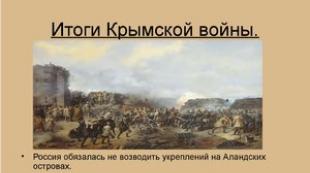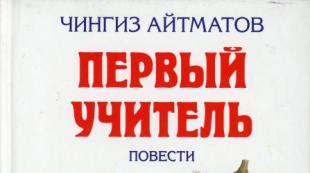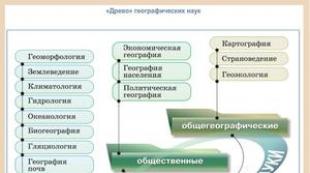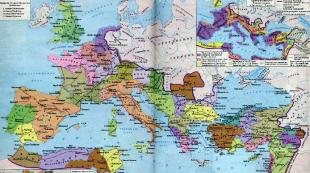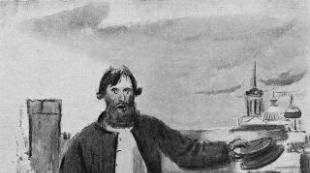Metaphor in simple words. The wealth of the Russian language: what is a metaphor in literature. The parable of the rose
metaphor, metaphor examples
Metaphor(from ancient Greek μεταφορά - "transfer", "figurative meaning") - a word or expression used in a figurative meaning, which is based on an unnamed comparison of an object with any other on the basis of their common feature. The term belongs to Aristotle and is associated with his understanding of art as an imitation of life. Aristotle's metaphor, in essence, is almost indistinguishable from hyperbole (exaggeration), from synecdoche, from simple comparison or personification and assimilation. In all cases, there is a transfer of meaning from one word to another.
- An indirect message in the form of a story or figurative expression using a comparison.
- The turn of speech, consisting in the use of words and expressions in a figurative sense, based on some kind of analogy, similarity, comparison.
There are 4 “elements” in the metaphor:
- Category or context
- An object within a specific category,
- The process by which this object performs a function,
- Application of this process to real situations, or intersections with them.
In lexicology, a semantic relationship between the meanings of one polysemantic word, based on the presence of similarities (structural, external, functional).
Metaphor often becomes an aesthetic end in itself and supplants the original original meaning of the word. In Shakespeare, for example, it is often not the original everyday meaning of the statement that is important, but its unexpected metaphorical meaning - a new meaning. This puzzled Leo Tolstoy, who was brought up on the principles of Aristotelian realism. Simply put, a metaphor not only reflects life, but also creates it. For example, Major Kovalev's nose in Gogol's general's uniform is not only personification, hyperbole or comparison, but also a new meaning that did not exist before. The Futurists did not strive for the plausibility of the metaphor, but for its maximum distance from the original meaning. For example, "a cloud in pants". Researchers note the relatively rare use of the metaphor in Soviet fiction, although there is no need to talk about its “expulsion” (see, for example: “So we parted. The stomp ceased, and the field was empty” (A. Gaidar, “The Fate of the Drummer”) In the 1970s, a group of poets appeared who inscribed on their banner "metaphor in a square" or "metametaphor" (term by Konstantin Kedrov). Distinctive feature metaphor is its constant participation in the development of language, speech and culture in general. This is due to the formation of a metaphor under the influence of modern sources of knowledge and information, the use of metaphor in defining the objects of technical achievements.
- 1 Types
- 2 Theories
- 3 See also
- 4 Notes
- 5 Literature
- 6 References
Views
In the modern theory of metaphor, it is customary to distinguish between aperture (a sharp, contrasting metaphor) and an epiphora (a familiar, erased metaphor)
- A harsh metaphor is a metaphor that brings together concepts that are far from each other. Model: filling of the statement.
- An erased metaphor is a generally accepted metaphor, the figurative character of which is no longer felt. Model: chair leg.
- The metaphor-formula is close to the erased metaphor, but differs from it in even greater stereotype and sometimes the impossibility of converting into a non-figurative construction. Model: the worm of doubt.
- An expanded metaphor is a metaphor that is consistently implemented throughout a large piece of a message or the entire message as a whole. Model: Book hunger does not go away: products from the book market more and more often turn out to be stale - they have to be thrown away without even trying.
- A realized metaphor presupposes operating with a metaphorical expression without taking into account its figurative nature, that is, as if the metaphor had a direct meaning. The result of the realization of a metaphor is often comic. Model: I lost my temper and got on the bus.
Theories
Among other tropes, metaphor occupies a central place, as it allows you to create capacious images based on bright, unexpected associations. the basis of metaphors can be based on the similarity of the most diverse attributes of objects: color, shape, volume, purpose, position, etc.
According to the classification proposed by N.D. Arutyunova, metaphors are divided into
- nominative, consisting in replacing one descriptive meaning with another and serving as a source of homonymy;
- figurative metaphors serving the development of figurative meanings and synonymous language means;
- cognitive metaphors resulting from a shift in the compatibility of predicate words (meaning transfer) and creating polysemy;
- generalizing metaphors (as the end result of cognitive metaphors), erasing the boundaries between logical orders in the lexical meaning of the word and stimulating the emergence of logical polysemy.
Let's take a closer look at metaphors that contribute to the creation of images, or figurative ones.
In a broad sense, the term "image" means a reflection in the mind of the external world. In a work of art, images are the embodiment of the author's thinking, his unique vision and a vivid image of the picture of the world. The creation of a vivid image is based on the use of similarities between two objects that are far from each other, practically on a kind of contrast. In order for the comparison of objects or phenomena to be unexpected, they must be sufficiently dissimilar to each other, and sometimes the similarity can be completely insignificant, imperceptible, giving food for thought, or it can be absent altogether.
The boundaries and structure of the image can be practically any: the image can be conveyed by a word, phrase, sentence, superphrasal unity, it can take up a whole chapter or cover the composition of a whole novel.
However, there are other views on the classification of metaphors. For example, J. Lakoff and M. Johnson distinguish two types of metaphors considered in relation to time and space: ontological, that is, metaphors that allow us to see events, actions, emotions, ideas, etc. as a kind of substance (the mind is an entity , the mind is a fragile thing), and oriented, or orientational, that is, metaphors that do not define one concept in terms of another, but organize the entire system of concepts in relation to each other (happy is up, sad is down; conscious is up, unconscious is down).
George Lakoff in his work "The Contemporary Theory of Metaphor" talks about the methods of creating a metaphor and the composition of this means of artistic expression. A metaphor, according to Lakoff's theory, is a prosaic or poetic expression, where a word (or several words) that is a concept is used indirectly to express a concept like this one. Lakoff writes that in prosaic or poetic speech, the metaphor lies outside the language, in thought, in the imagination, referring to Michael Reddy, his work "The Conduit Metaphor", in which Reddy notes that the metaphor lies in the language itself, in everyday speech, and not only in poetry or prose. Also Reddy states that "the speaker puts ideas (objects) into words and sends them to the listener, who extracts ideas / objects from words." This idea is reflected in the study of J. Lakoff and M. Johnson "Metaphors We Live By". Metaphorical concepts are systemic, “the metaphor is not limited to only one sphere of language, that is, the sphere of words: the processes of human thinking themselves are largely metaphorical. Metaphors as linguistic expressions become possible precisely because there are metaphors in the conceptual system of a person. "
Metaphor is often viewed as one of the ways to accurately reflect reality in artistic terms. However, I. R. Halperin says that “this concept of accuracy is very relative. It is the metaphor that creates a concrete image of an abstract concept that makes it possible to interpret real messages in different ways ”.
As soon as the metaphor was realized, isolated from a number of other linguistic phenomena and described, the question immediately arose about its double essence: to be a means of language and a poetic figure. The first who opposed the poetic metaphor to the linguistic one was S. Bally, who showed the general metaphor of the language.
see also
- Figure (rhetoric)
- Analogy
- Comparison (rhetoric)
- Conceptual mixing
- Phraseologism (idiom)
- Analogue
- Metonymy
Notes (edit)
- TWO KINDS OF METAPHOR
- Galperin I. R. Essays on stylistics of English language... Moscow: 1958
Literature
- Ankersmit F.R. History and tropology: the rise and fall of a metaphor. / per. from English M. Kukartseva, E. Kolomoets, V. Kashaev - M .: Progress-Tradition, 2003 .-- 496 p.
- Klyuev E. V. Rhetoric (Invention. Disposition. Elocution): Tutorial for universities. - M .: PRIOR, 2001.
- Kedrov K.A. Metametaphor. - M., 1999.
- Lakoff D., Johnson M. The Metaphors We Live By. - M .: Editorial URSS, 2004.
- Moskvin V.P. Russian metaphor: Essay on semiotic theory. - 3rd ed. - M., 2007.
- Haverkamp A. Metapher. Die Ästhetik in der Rhetorik. - München: Wilhelm Fink Verlag, 2007.
Links
Wikiquote has a page on the topic- Nikonenko S.V. Analytical interpretation of the metaphor (2003)
- Metaphor and its types
| Figures of speech | |
|---|---|
| Shapes |
Adynaton allusion Amplification Anadiplosis anacoluthon anaphora antithesis Antiteton apocope apostrophe Attraction asyndeton hyperbaton homeoteleuton Graduation (climax, anticlimax) Distinction Zeugma Izokolon nominative topics Inversion Correction Mezarhiya Mnogopadezhnost (Poliptoton) polysyndeton Oxymoron Parallelism paronomasia parceling paraphrase Pleonasm prolepsis retardation rhetorical question rhetorical exclamation apostrophe symploce solecism tautology Exact repetition Default Chiasm Exergasia Ellipsis Emphase Epiphora |
| Trails |
Allegory Anphrasis Asteism Antonomasia Hyperbole Dysphemism Irony Pun Catachreza Litota Meiosis Metonymy Impersonation Paphos Periphrase Sarcasm Synecdochus Comparison Euphemism Epithet |
metaphor, metaphor wikipedia, metaphor vikipedia, metaphor degen not, metaphor meaning, metaphor definition, metaphor butt, metaphor examples, metaphor wikipedia, metaphor what is
Metaphor Information About
Metaphor Is a word or a combination of words used to describe an object in a figurative sense, based on similar features with another object. The metaphor serves to emotionally embellish colloquial speech. It often supplants the original meaning of the word. The metaphor is used not only in colloquial speech, but also performs certain functions in literature. It allows you to give an object, an event a certain artistic image. This is necessary not only to strengthen a certain feature, but also to create a new image in the imagination, with the participation of emotions and logic.
Examples of metaphors from literature.
We bring to your attention examples of metaphors:
“A Christmas tree was born in the forest, it grew in the forest” - it is clear that a Christmas tree cannot be born, it can only grow from a spruce seed.
One more example:
"Cherry cherry
Bloomed with spring
And the branches are golden
What curls, curled. "
It is also obvious that bird cherry cannot curl curls; it is compared to a girl in order to clearly show how beautiful she is.
Metaphors can be sharp, this type connects completely different semantic concepts, for example, "filling of a phrase", it is clear that a phrase is not a pie and it cannot have a filling. Also, metaphors can be expanded - they can be seen, but rather listened to throughout the entire utterance, such an example is an excerpt from the novel by A.S. Pushkin "Eugene Onegin":
“The night has many lovely stars,
There are many beauties in Moscow.
But brighter than all the friends of heaven
The moon is in the blue air. "
Along with detailed and harsh metaphors, there is an erased metaphor and a metaphor-formula, which are similar in their features - giving the object a figurative character, for example, a “sofa leg”.
How often do you meet people who know how to speak pure Russian, without repetition and banal, so as to hypnotize the interlocutor from the first words, and cover with a stream of thought, carry him to the very end of the dialogue, not letting the thread of the conversation slip and carefully observing that Is the text presented interesting to the listener?
Often, experienced announcers, writers and people whose profession, in one way or another, is connected with communication and literature, are able to make such an impression on the interlocutor, to find his weak points. They succeed in this thanks to many different tricks, including when using literary speech - tropes. One of the paths that help make a statement brighter, the metaphor is juicier and more imaginative. And we will try to understand what it is, and what is its essence and meaning.
History of metaphor
I would like to write something about the birth of metaphor, but, fortunately, or vice versa, this is impossible. It was born, perhaps, together with language, imagination, and with a person in principle. With him, she grew and developed.
 So what is a metaphor in literature? If we consider this issue in the least detail, then we can say that this is a comparison, but digging deeper, the definition will be more extensive for you. Metaphor - figurative comparison one object with another based on any properties, this rule, by the way, the futurists tried to bypass and ignore as much as possible. The meaning of this path for them is the transfer of feelings, emotions and pictures in front of the eyes of the reader. Examples of outrageous futuristic metaphor in Mayakovsky's poems are countless, so it's worth dwelling on:
So what is a metaphor in literature? If we consider this issue in the least detail, then we can say that this is a comparison, but digging deeper, the definition will be more extensive for you. Metaphor - figurative comparison one object with another based on any properties, this rule, by the way, the futurists tried to bypass and ignore as much as possible. The meaning of this path for them is the transfer of feelings, emotions and pictures in front of the eyes of the reader. Examples of outrageous futuristic metaphor in Mayakovsky's poems are countless, so it's worth dwelling on:
- Behind the sun of the streets, a flabby moon, which no one needed, hobbled somewhere - the poet compares the moon to an old woman, feeble and lonely;
- Street flour silently pearl.
The shout stood out from his throat.
Puffed up, stuck across the throat,
Plump taxis and bony bunks.
The chest was pedestrianized.
Consumption is flatter. - this poem describes a comparison where the street is likened to a sick person;
- On the pavement
my soul worn out
footsteps
they make harsh phrases of the heel. - in the same poem, on the contrary - the person himself is likened to the street.
- Throwing the milky way like a gallows, take and pull me up, a criminal. - an incredible sentence that clearly describes the meaning of how the writer sees the starry sky, namely, comparing the Milky Way with a rope for the gallows, where the author should be hung.
 We learn about metaphor as a literary path since teachings of Aristotle, who believed that it should be as close as possible to the truth and personify an undeniable similarity to the subject. The philosopher of antiquity was sure that art, including literature, should maximally convey the realism of the surrounding life of the creator, this is its essence and significance.
We learn about metaphor as a literary path since teachings of Aristotle, who believed that it should be as close as possible to the truth and personify an undeniable similarity to the subject. The philosopher of antiquity was sure that art, including literature, should maximally convey the realism of the surrounding life of the creator, this is its essence and significance.
But, over time, opinions about the property and comparison functions have noticeably changed, and during the era of futurism, which was mentioned a little above, the creators came to the conclusion that this complex comparison should be used to make the reader think about why the author wanted to say exactly so and in what he saw the comparison.
In general - a metaphor, it is description of worldview the writer himself, a path, the essence of which is to convey the images swarming in the head of the writer, and to give the reader the opportunity to imagine the author's point of view as clearly as possible.
Structure and principles of metaphor
The metaphor itself is multifaceted and complex concept, in which everything is not so easy to sort out on the shelves, as it might seem at first glance, but everyone has the right to a chance, so we will try.
Components of building a metaphor
Such a multifaceted comparison, reflecting the whole essence of the author's inner world and his vision of life, cannot but be structured, according to at least some dogmas and the law of literary vocabulary. So let's consider semantic elements, which are represented as particles of a single integral canvas - metaphors.
Let's consider the components using the example of such a metaphor: "she faded, losing her charm."

Types of metaphor
There are two main types of metaphors - dry and expanded. The differences between them are obvious and immediately striking, so the question of how to find a metaphor should not arise, even among inexperienced readers.
Dry metaphor- comparison, often already firmly entrenched in everyday life, which is sometimes difficult to notice in a conversation, for example:
- The eyeball is a metaphor whose meaning is obvious, and the comparison is in the word apple, due to the similarity of forms;
- The leg of the cabinet is a leg, this is a comparison used due to the fact that it is a support, just like the human lower limbs, although the furniture obviously cannot move on it;
- Golden words - naturally, words are not made of a precious stone, but such a parallel has been drawn due to the great value of the spoken;
- Burning foliage - in fact, the foliage does not glow, its color is just very reminiscent of a fire, by the way, the time of “burning foliage” is a favorite time of Pushkin, who is also one of the fans of using bright metaphors in his poems.
Expanded metaphor people of literature often use it. This comparison can last over a line, sentence, paragraph, page, or book.
 So, we can conclude that our language is rich and diverse. Moreover, it is vast and great. A huge number of writers, poets and philosophers have been proving these simple truths for centuries. From the great mind of Aristotle to Pushkin, Lermontov, Tolstoy and, in the end, Mayakovsky and Vysotsky. They all talked about the delights of native conversation. And we only need to remember that a word can both kill and heal. Master your native speech and find beauty in everyday life, good luck.
So, we can conclude that our language is rich and diverse. Moreover, it is vast and great. A huge number of writers, poets and philosophers have been proving these simple truths for centuries. From the great mind of Aristotle to Pushkin, Lermontov, Tolstoy and, in the end, Mayakovsky and Vysotsky. They all talked about the delights of native conversation. And we only need to remember that a word can both kill and heal. Master your native speech and find beauty in everyday life, good luck.
Metaphor- This is perhaps the most common type of trail. At the heart of metaphors lies. Probably everyone remembered the definition from school: “ Metaphor - hidden comparison". But it is not always clear what was hidden there. And they hid - the first part of the comparison. For example, comparison: “ The dawn in the eastern sky burns like a fire". Beautiful? I guess, yes. But not very succinctly. And now a metaphor: “ The east is burning with a new dawn"... It is worth closing the part of the comparison -" like in a fire "(after all, it’s clear what this is about!), As the phrase acquires a completely different sound, imagery and ambiguity appear. The resulting text from folding the comparison into a metaphor only wins.
D.N. Ushakov highlights two main models by which metaphors are formed... The first is based on personification, and the second is based on reification.
Personifying metaphors, according to the linguist, are the most ancient in the language: "Snow lies", "frost bound the rivers", "the stream is running," "the year has flown by," "time has stopped," "longing is gnawing," "boredom has eaten," "feelings are fading away"... Actually, this is the personification, which is usually distinguished as a separate type of expressive means.
Reifying metaphors: "iron will", "deep sadness", "subtle thought", "bitter smile", "sweet speech", "tongues of flame", "door handle". As you can easily see, this is.
Such is the close connection between the expressive means of the language, which often makes it difficult to distinguish a certain path and allows us to talk about syncretism of expressive means.
The metaphor makes our speech more expressive, memorable, and our poems lively and colorful. A lucky metaphor evokes a positive response from the reader, generates many associations, acts not so much on the mind as on the feelings, the subconscious. It is not for nothing that NLP pays a lot of attention to the correct selection of metaphors in the text.
At metaphorization of speech the poet rarely confines himself to just one metaphor. There are many of them. Usually he needs metaphors to form a memorable image, so all metaphors obey one unspoken rule. In each poem - its own. If, for example, the author uses cliché metaphors, he usually does not look for bright tropes. In contrast, in a poem adorned with unusual metaphors, one unsuccessful metaphor sounds false and ridiculous.
So, metaphors are original and commonplace... There are quite a few metaphors-clichés, we use them every day: forest of hands, toe of a boot, put down roots, make ends meet, go like clockwork, view from the top... Such erased metaphors hardly capable of hitting someone. They will not add imagery to your poetry. We need to look for new ways of expression.
Simple metaphors consist of two or three words and describe the subject only from one side. The above cliché metaphors are a prime example of simple metaphors. But don't think that all simple metaphors are banal. You can come up with a simple, vivid metaphor: skyscraper of papers, dust of stars etc.
But more often poets use expanded metaphors... Moreover, the scope of the poet in metaphorization sometimes reaches such a width that metaphor turns into symbol... For example, the metaphorical image of a sail in the poem by M.Yu. Lermontov's "A lonely sail whitens" turns into a symbol of loneliness.
A detailed metaphor covers several phrases or even an entire poem. In the work of each poet, you can find many examples of a detailed metaphor. V. Mayakovsky was especially fond of detailed metaphors.
Parade unfolding my pages of troops,
I go along the line front
Poems are hard lead
ready for death and immortal glory
The poems froze, pressing the throat to the vent
targeted gaping titles.
The weapon of the beloved kind,
ready to dash into a boom
the cavalry of jokes froze,
lifting rhymes sharpened peaks.
And all the armed troops on top of their teeth,
that twenty years in victories flew by,
until the very last leaf
I give you, proletarian planets.
This is an expanded metaphor for poetry. In Sh. Baudelaire's poem "Carrion", the description of the insides of a dead horse is a metaphor for life and death.
That was a shaky chaos, devoid of forms and lines,
Like a first sketch, like a stain,
Where the gaze of the artist sees the camp of the goddess,
Ready to lie down on the canvas.
By the way, in the same poem, Baudelaire uses many detailed comparisons. We read above:
And this world flowed with mysterious sounds,
Like the wind, like a running shaft,
As if a sower, gently raising his hands,
He fluttered grain over the cornfield.
Try as an experiment to "roll up" comparisons into a metaphor, at least in prose.
There are many expanded metaphors in the work of S. Yesenin.
You didn’t know
I'm in solid smoke
In a life torn apart by a storm
That's why I am tormented that I do not understand -
Where the rock of events takes us.
« Life shattered by the storm"- what a powerful metaphor! And further: the poet compares the earth with a ship:
When the sea surface is boiling
The ship is in a deplorable state.
Earth is a ship!
But someone suddenly
Per new life, new glory
Into the midst of storms and blizzards
He directed her majestically.
Well, which of us is big on deck
Didn't fall, vomit and curse?
There are few of them, with an experienced soul,
Who remained strong in the pitch.
Thus, Sergei Yesenin rises above the prose of life (after all, he could simply say: how bad it is without you, beloved woman! - but that would not be poetry, but vulgarity). And the strong way of life on earth, when it sways from side to side, like on a ship in a storm, when only the strong and experienced can withstand, impresses the reader and gives him a complete idea that life is difficult.
The purpose of a metaphor is to describe, not name! The reader must be imbued with the image, only then the poet will be able to influence him aesthetically.
Metaphors can and should be used. But do not forget that the metaphor must be realistic... Yes, it can be abstract, bright, unexpected (and it cannot be - but it should be: otherwise what imagery will appear in the text ?!), but it must always have real roots. It should always evoke associations, and not just be a pretty set of words.
INTRODUCTION
Metaphor is the most commonly used trope for creating imagery and expressiveness of a phenomenon. It is because of the love of prose writers and, especially, poets, to the reception of metaphorization, in the language one can observe a huge variety of its types. The metaphor helps to enhance the sensory impact of the writer through his work on the reader, since thanks to the hidden comparison, which is given in the text, it is possible to indicate the attitude towards a particular phenomenon.
Object of research: metaphors that are found in Mikhail Sholokhov's novel "Quiet Don".
Subject of research: ways of expression and options for using one or another type of metaphor in the text.
The relevance of the topic raised in this study lies in the fact that, thanks to a detailed analysis of the text, it is possible to identify specific features of metaphoricity in the novel, and this can help to avoid mistakes when using and writing these metaphors in any context other than the original.
The purpose of this study was to identify the features of metaphors in the novel by M. Sholokhov "The Quiet Don" and to determine their types, and then, through this, to deduce common features.
The following tasks were set:
Select and classify metaphors in M. Sholokhov's novel "Quiet Don";
Determine the features of the use of metaphors by M. Sholokhov in this novel.
The following methods were used:
Observation of language material;
Comparison of theoretical facts with linguistic phenomena.
The structure of the work: introduction, two chapters, conclusion, list of used sources.
CONCEPT of Metaphor. HER Kinds
Metaphors in the language of fiction
The Russian language is interesting by its nature. It has many facets, various directions, and it is impossible to list all of them at once. Studying our native language, one can get acquainted with the history of the development of the human soul, its rise and fall. The language speaks about its history brightly, colorfully, and, above all, it is reflected in fiction, since it is from it that we learn, how people spoke, thought, felt at a different time from ours.
Our Russian works are adorned with many turns. Most often, writers use just a metaphor, since it is simpler in appearance and makes it possible to convey their thought more colorfully. It can be found almost everywhere, in a wide variety of forms and interpretations. The study of this path will help in the future to understand what is the difference between the metaphors of an individual writer from the linguistic ones, but for now I would like to designate for a general understanding what a "metaphor" is.
"Metaphor (from the Greek metaphora - I carry it) - a kind of path in which individual words or expressions converge by the similarity of their meanings or by contrast" Introduction to literary criticism: textbook / L.N. Vershinin, V.E. Volkova, A.A. Ilyushin et al. 2005.S. 68-69 ..
Almost all parts of speech can act as a metaphor in the text: it can be a verb, an adjective, a noun, a participle, and a participle, etc. Its stylistic coloring lies in the fact that there is a transfer of signs from one object to another, thereby creating an image of something living, colorful or even spiritualized, sublime from the simple, familiar to our understanding.
Similarity transfer can occur based on:
Appearance;
Locations;
Item shapes;
Taste, smell;
Functions performed;
Feelings evoked (disgust, admiration, tenderness), etc.
There are four components involved in the creation of a metaphor: two separate subject-phenomena and the properties of each of them. The property of one class, selected for the formation of a metaphor, is attributed to the object-phenomenon of another class, thereby forming an integral unity. Thus, when a person is called "rat" or "fox", the properties of these creatures - greed and cunning, respectively, - turn out to be his general characteristic, a new image is created and a new meaning is generated.
Duality is also one of the hallmarks of metaphor. Its semantic structure includes two components - meaning as such (a property of the actual subject of the metaphor) and the image of a secondary, auxiliary subject from which this or that feature was written off.
There are a number of regularities in the metaphorization of the meaning of words-signs:
Transfer of a physical attribute of an object to a person (sharp, dull, deep, hard) to indicate mental properties;
The principle of atropomorphism and zoomorphism: actions / signs of animals or humans are transferred to nature, after which the object becomes an abstract concept (deep thought), and vice versa - signs of nature are transferred to animals and people.
Based on this, we can conclude that the processes of metaphorization can proceed in opposite directions.
The very same term "metaphor" was introduced by Aristotle, and first of all it has a connection with the understanding of art as an imitation of life. In fact, Aristotle did not distinguish metaphor from synecdoche, personification, assimilation or hyperbole, for in all cases there is a transfer of meaning from one concept / object to another. Since the time of the great thinker, the metaphor has been considered as an abbreviated comparison, in other words, such a comparison where there were no similarity predicates and comparative conjunctions (similar to, reminds; as, as if, as if, etc.). The difference between comparison and metaphor is observed in several ways:
Conciseness: metaphor, in contrast to comparison, shortens speech, makes it more aesthetic and elegant, while comparison spreads it, trying to give color to the description of the sign of similarity;
Revealing the kind of similarity: While comparison favors both permanent and incidental similarities, metaphor relies on constant, deep similarities.
If we consider in more detail a metaphor as a kind of path, then we get the following definition: a metaphor is a kind of path, the basis of which is an association by analogy or similarity. Like many other tropes, metaphor is not only a technique of the poetic genre. It is a common linguistic path that can be used both in high literature and in the simple speech of people.
It also happens that some words or phrases, formed metaphorically and used only in a metaphorical form, soon lose their original meaning and are used only in a figurative meaning, which is now accepted as direct. Most often, this kind of metaphorical origin is revealed in phrases. However, if we are talking about metaphor as a stylistic phenomenon, then we should not forget that not only a figurative, but also a direct meaning should be felt in a phrase or word.
In a metaphor, it is most often possible to restore the method of opposition, which is, as it were, cut out of it. “Who are these people? Flies! (not people) ”(Gogol). Contrasting gives us at least an approximate understanding of how the author characterizes the subject of his description.
In addition to metaphoric words, metaphorical images, or expanded metaphors, have become widespread in literature. They can be a phrase, part of a sentence, the sentence itself, or a whole text - it all depends on what the author wants to say and how he wants to say it.
“Metaphor is a dream, a dream of the tongue,” says David Davidson. - The interpretation of dreams needs the cooperation of the dreamer and the interpreter, even if they agree in one person. Likewise, the interpretation of metaphors bears the imprint of both the creator and the interpreter. ”Davidson D. What Metaphors Mean. M., 1990.S. 173-193. ...
If there is a polysemy, then it is due to the fact that in a simple context the word has one meaning, but in a metaphorical context it is completely different. There are two different meanings in a metaphor - literal and figurative. The literal meaning can well be represented as something that we feel, something hidden, something that affects us without openly manifesting itself in the context, while carrying the main load in the figurative meaning.
In appearance, the metaphor is more like an unusual, not everyone understandable language, but this does not make it less commonly used in literature, not only Russian, but also foreign. Metaphor - there is a single whole, the members of which are interdependent in their meaning from each other. That which was compared is repressed and replaced by that with which it was compared.
Metaphor can perform following functions Metaphor function [Electronic resource]. Access mode: http://helpiks.org/1-22443.html .:
1. Characterization - gives someone or something, a positive or negative characteristic, using the transfer of the properties of one object to another; most often, the predicate acts as a metaphor ("He is a real bull" - it means either a fierce character of a person, or his unreal dimensions);
2. Nomination - the nomination of the objects of action, that is, the one who commits is named on the basis of association with what he does; most often the phrase "subjects + addition" acts as a metaphor;
3. Informative function - transfer of integrity, panoramic image: connection huge amount unconscious to a mental holistic display; any metaphor carries aesthetically colored information;
4. Style formation - the participation of metaphors in the creation of the style of fiction; the degree of metaphoricity of a literary text depends on the attitudes of the author;
5. Text formation - as mentioned above, the metaphor can be expanded, and it is this property that is the basis of this function;
6. Genre education - the participation of metaphors in creating the atmosphere of a particular genre; for example, for riddles, proverbs, odes, aphoristic miniatures, etc., a metaphor is almost mandatory;
7. Emotional evaluative function is a way of metaphor to influence the reader by awakening any emotions in him ("Dumb boy" - a stupid, uncouth boy who is treated with disdain).
So, having considered the concept of metaphor, its properties and functions, we can proceed to the study of its types.
